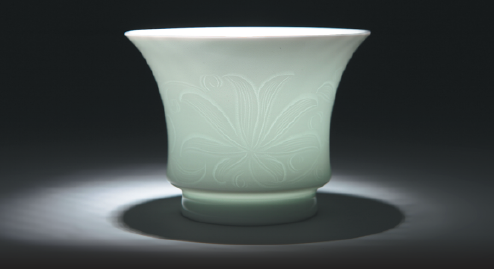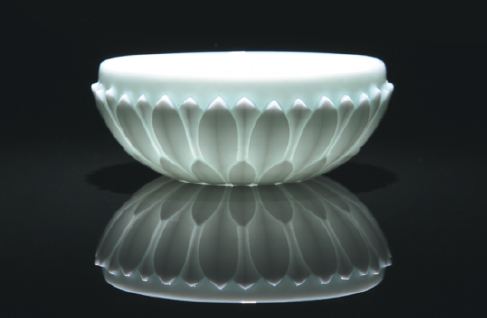The color of excellence
Dedication of one man sees translucent glaze of Qingbai porcelain make a comeback, Yang Feiyue reports.

If Qinghua (blue and white) porcelain is the crown jewel of porcelain capital Jingdezhen in East China's Jiangxi province, Qingbai (bluish white) porcelain is its hidden gem. Though their names may be similar, the finished results are vastly different.
A far cry from the vibrantly contrasted coloring of Qinghua porcelain, Qingbai porcelain has a more reserved quality.
"It is blue as the sky, bright as jade, thin as paper, and resonant like a chime," says Wang Shangbin, who for decades, has been committed to restoring the Qingbai porcelain, which dates back to the Song Dynasty (960-1279).
"In appearance, it is characterized by its translucent glaze, which glows white with a hint of green here, and green with a hint of white there, giving it a jade-like quality," he says.
The porcelain is also known for its hidden relief patterns, which become visible from both inside and out, when held up to the light, he adds.
Historical records show that during the Song Dynasty, Qingbai porcelain was widely produced in most parts of southern China. As one of the first varieties of porcelain, it laid a technical foundation for the development of others, including Qinghua, as well as red underglaze, red and green overglaze, and famille rose (fencai or yangcai in Chinese, a kind of porcelain painted mostly in shades of pink).
The artisan, who is in his early 60s, leads a tranquil life that mainly revolves around Qingbai porcelain. He drives to his workshop in Jingdezhen after breakfast to begin making porcelain with a group of like-minded masters of the craft.
They have reproduced many Song Dynasty-style porcelain items, some of which have been collected by domestic museums and purchased by collectors from abroad.
Born and raised in Jingdezhen, Wang has been immersed in ceramics and its culture and history for most of his life.
During the 1980s, he followed cultural heritage and museology expert Gong Mingxun in studying ancient porcelain, and at first, focused on studying and appreciating porcelain from the Ming (1368-1644) and Qing (1644-1911) dynasties.
That was until 1989, when two Qingbai porcelain cups at an antique market in Shanghai caught his eye. They were being sold by a fellow Jiangxi native, and were a revelation to Wang, who wasn't aware of the existence of Qingbai at that point.
"No one showed any interest as they all mistakenly thought they were new pieces," Wang says. "The seller was desperate as he didn't have enough money to return home, so I bought the cups from him to help him out."
When he later showed his purchases to Gong, the expert immediately identified them as Qingbai porcelain from the Song Dynasty kiln in Jingdezhen. "This sparked my interest in Qingbai and prompted me to start paying attention to it in the market," Wang says.
He began frequenting museums across the country to study examples of the porcelain, cementing his lifelong love for the style. "I saw many beautiful pieces in museums and gradually, I began to understand and appreciate them," he says.
Experts say that the aesthetic of Song Dynasty Qingbai porcelain is more elevated than that of Ming and Qing ceramics, due to its simplicity, elegance, exquisite craftsmanship and naturalism.
Influenced by the refined tastes of Song scholars, the style embodies tranquillity and harmony, making it both a pinnacle of ceramic art and a significant influence in the history of porcelain.
Wang also started to look into ancient kiln sites, conducting examinations both inside and outside the kilns to improve his knowledge of the history and characteristics of Qingbai porcelain. "There were still many well-preserved examples in the Nanhe and Xiaonan river basins in Jingdezhen," Wang says.
His investigations were extensive, including detailed analyses of kiln structures, production processes, material collection and preparation, as well as workshop layouts. It laid a strong foundation for his effort to restore the crafting process of Qingbai porcelain.
Since the original Qingbai porcelain workshops had long disappeared, and the techniques for making it were lost during the Ming and Qing dynasties, there were almost no traces left in terms of the techniques used to mold, carve and sculpt the clay.
Wang dug into historical documents, such as the Tao Ji (Records on Ceramics), from the Song Dynasty, that elaborated on the raw materials and formula for Qingbai porcelain, and used what he learned to practice, trying over and over to re-create pieces based on the characteristics of Song artifacts.
He also sought out natural weathered porcelain stone, clay, and other materials from Jingdezhen, such as burned wood ash and limestone, that were recorded in the ancient books, to further his experiments.
"Using what I learned from museums, kiln site investigations, and ancient ceramic samples I found, I practiced the refiring techniques used to make Qingbai porcelain," Wang says.
Through trial and error, Wang was able to come up with an equivalent of the original formula.
In 2001, Wang built a Song-style stepped bricked kiln on a sloped hill, with an inclination of around 21 degrees. Using pine and other miscellaneous wood as fuel, the kiln can reach a maximum temperature of 1,330 C, and remains in use today.
Then, he found a source of premium clay several meters beneath the surface of the mountains surrounding the Xiaonan River, based on his knowledge from his research and readings of the historical documents concerning the related ancient kilns.
The crushing of clay is generally done using stone wheels, but for finer processing, manual work is still required.
"The size of the glaze particles is crucial," he says.
If they are too small, the glaze will fail to stick properly to the surface, resulting in patches, where it flakes off or "jumps" away, Wang explains. "If they are too coarse, it is difficult to achieve a translucent texture.
"The glaze material must also be free of impurities, so magnets and fine filters are used to remove them. This helps prevent the appearance of black spots and iron marks after firing," he adds.
When the porcelain clay is dewatered and filtered, it has to be stored in a cool, sealed environment for aging, which is crucial to its plasticity.
The clay generally needs to be stored for at least six months before it can be used and then must be properly kneaded by hand to ensure it is evenly prepared.
Additionally, Qingbai porcelain requires much higher standards for throwing, compared to other types of porcelain. Throwing is a crucial step in the process of creating pottery, where clay is shaped on a pottery wheel.
"If it isn't thin enough, it won't achieve the desired translucency. Soft, wet clay can easily be ruined during the shaping process, if it isn't handled carefully, requiring the potter to execute precise movements with great delicacy," Wang says.
Once a piece is made, it is trimmed, a demanding process due to the extremely thin shell. Other key steps include half-carving, a decorative technique from the Song Dynasty, as well as glazing, and firing.
Using small iron or bamboo knives, designs are carved into the dried clay, creating patterns of varying depths — deep on one side, shallow on the other. Each line has a gradient, alternating between solid and hollow, giving the impression of a raised design.
"This technique demands a high level of skill. If the carving is not deep enough, the design lacks dimension and life; if it is too deep, it risks breaking the clay," Wang says, adding that for glazing, the thickness and immersion time are key.
To bring Qingbai porcelain to a wider audience, he and his brother Wang Shuibin established a research society in 2011 that has brought together Qingbai porcelain collectors and experts.
Over the past decade, he has organized 10 Qingbai porcelain and porcelain tool exhibitions, which have attracted young craftsmen to the art.
Local authorities have become involved with the revival of Qingbai porcelain, and the Jingdezhen Ceramic University now offers classes.
The brothers also started a business making scale production that has added to the tapestry of porcelain culture in the city.
"The Wang brothers successfully revived traditional Qingbai porcelain techniques that had been lost for over 700 years," says Li Feng, deputy director of the Jiangxi artistic ceramics standardization technical committee. "This achievement is a miracle in the preservation of Jingdezhen's traditional intangible cultural heritage."
However, the path to preserving and passing down these techniques still faces many challenges and bottlenecks, Li says, adding that the public has a low awareness of Qingbai porcelain, and mass production has yet to be realized.
This all leads to relatively higher costs for pieces, making it difficult to promote Qingbai porcelain sustainably.
"Additionally, handcrafted Qingbai porcelain requires precise control of shape, carving techniques, glaze thickness, and firing conditions. Variations in artisans' skills and methods significantly affect the consistency of quality," Li says, adding that standardization should be introduced to codify techniques.
"By standardizing techniques and archiving them for educational purposes, more young people and ceramic artisans can learn from them and reference them. This will lay a solid foundation for the dissemination and passing on of Jiangxi porcelain culture," Li says.

































